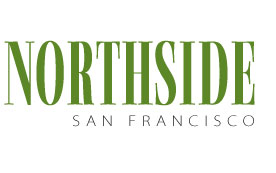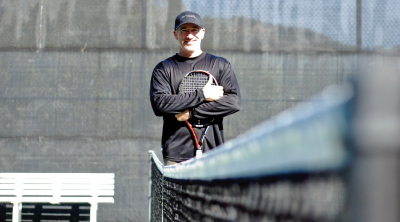 |
 |
|||||||
|
Cover Story  There's an iconic slice of tennis Americana residing just north of the Golden Gate Bridge, and he wants to make you a better tennis player. But no worries – if that's not on your agenda, Brad Gilbert will be happy to offer you refreshments and tell you some fascinating stories about the good old days. We are talking about a guy who counts Metallica's drummer Lars Ulrich among his tennis buddies, after all. Remember the heyday of tennis in the United States? When temper tantrums, big sideburns, and petulant bravado were all the rage? When playing the game had less to do with technology and more to do with instinct?He does. In fact, Gilbert was ranked No. 4 in the world back in 1990, ahead of legends like Mats Wilander and Jimmy Connors. (Gilbert also has an Olympic bronze medal from Seoul in 1988, which he admiringly calls “the big penny.”) Remember when, practically out of the blue, a seemingly washed-up Andre Agassi transitioned from being a brash young punk in neon tights to a cunning strategist who won six Grand Slam titles between 1995 and 1999? He does. In a masterful coaching job, Gilbert enticed Agassi to end his unnecessary quest for perfection. “Instead of you succeeding, make him fail,” he said. Agassi listened, and a new American hero was born. If you follow the sport of tennis these days, you know Gilbert for his inimitable sense of humor and his quirky insight into the catacombs of a tennis player’s psyche. But there’s also his ubiquitousness. It’s hard not to know him. Click on the TV and there he is – a tiny black microphone pinned to his lapel and white-hot studio lights illuminating his face – ardently expressing his opinions about the stars of the professional game. Cut to commercial and there he is again, singing the praises of the “wrist-assist” in a 60-second television spot. Walk into a bookstore and there are the books he’s written. It’s called color commentating, but with Gilbert it’s the tennis version of abstract art on TV. He’s not scripted, because ESPN is wise enough to know that he’s at his best when he’s improvising. The Marin County resident, Bikram yoga advocate, and avid dog walker may not possess the polish of a Dick Enberg, but he certainly doesn’t lack the passion. Perpetually oozing enthusiasm, he smiles on camera like a man fully aware of how rewarding it is to be talking about tennis for a living. “I have to pinch myself that I get to do tennis for a living,” he says. “I got to play, I’ve coached, and now I get to talk about it – it’s humbling.” Mixed into his on-air dialogues are steady flows of what have come to be known as “Brad-isms.” They are Gilbert’s well-intentioned attempts at encouraging the audience to lighten up. When he commentates, he rattles off a ceaseless flow of dry humor in a stream-of-consciousness manner. Some of it’s so dry that you don’t even know it’s humor, for example: “That scoreboard is frozen pizza,” or “Oh no, he’s taking out the ‘fearhand’ now.” What? But Gilbert is at his most impressive when he recognizes patterns of play and informs the viewer about the strategic or psychological elements of the match. Like a true savant, he has a knack for noticing patterns that are invisible to the common eye. But who is the man behind the seemingly endless tennis banter? And just what is it that he possesses that has made him one of the most successful tennis coaches in American history? That’s a question Gilbert would prefer to leave unanswered. He wouldn’t want to overthink things or let his mind get in the way of his body’s natural swing. This is the man, after all, who told Andre Agassi that his quest for perfection was making everyone miserable. At their impromptu job interview (at Agassi’s behest) in Key Biscayne in March 1994, Agassi asked Gilbert to deconstruct his game for him. “Be like gravity,” Gilbert said. “Don’t chase something that doesn’t exist. Just be solid.” Gilbert ended up landing the job that he didn’t know he was being interviewed for, and the rest was history. Agassi took him to heart and flourished under his tutelage, rising to new heights as he embraced Gilbert’s version of tennis psychology, which he later coined as “Braditude.” Gilbert finished his playing career in 1995 to become Agassi’s full-time coach, and yet remarkably, he is still ranked among the top-100 earners in the history of the sport 15 years later. If that doesn’t convince you this man has game, you can check the stats: 519 career match wins, 20 career titles, and a No. 4 ranking in the world in 1990 are further proof that the man called “BG” is someone Bay Area tennis enthusiasts can embrace as proof of our strong tennis heritage. Gilbert was universally known for doing more with less throughout his impressive playing career, because he inherently understood that less, on most occasions, was more. This same earnest simplicity, applied to his protégés, has allowed him to quickly earn a reputation as one of the most successful coaches in American tennis history. Agassi has said that nobody knows the game better. Tennis oozes from Brad Gilbert’s pores. It’s on the tip of his tongue, and it’s in the back of his mind. And here I was, across the net from a living legend, trying to avoid embarrassing myself. I was overcome by a sense of the surreal as we traded backhands on his home court nestled quaintly in the Marin hills. Want to find out more about tennis? Stop by Brad Gilbert’s Tennis Nation in San Rafael to chat with his expert staff or pick up some gear and head to the courts. If you’re lucky you may run into Gilbert himself. Or visit him on the web at www.bradgilberttennis.com. Chris Oddo is a freelance sportswriter who is based in San Francisco, California. When he’s not writing he can be found with a racquet in his hand and tennis shoes on his feet.
|
||||||||
 |
||||||||
|
||||||||
 
|
||||||||


